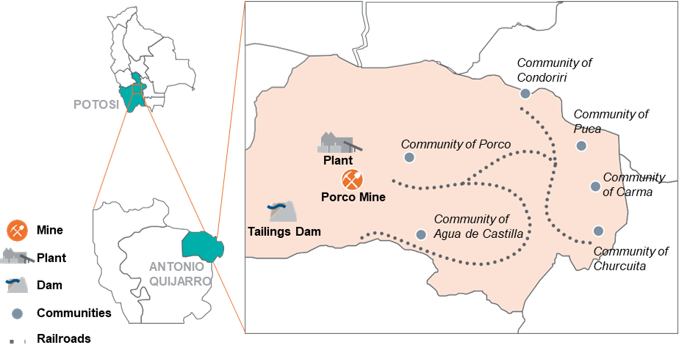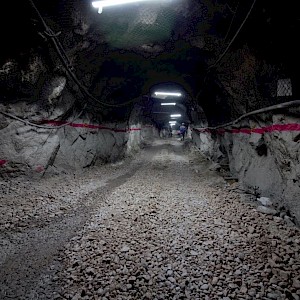Porco Mine, Bolivia
-
Overview
The Porco Mine has been active for nearly 500 years and is currently producing Zinc/Silver and Lead/Silver concentrates. The complex consists of an underground mine, concentrator plant, maintenance workshop, tailing storage facility, water treatment plant, supplies warehouse, main office, two hospitals and Yancaviri Camp. Located 50 km southwest of Potosí City in Antonio Quijarro province comprised of two underground mining sectors: Central and Hundimiento.
-
Location
The Porco complex is located in the Porco Municipality of the Antonio Quijarro Province, in the Potosí Department, Bolivia. 50 km southwest of Potosí City, via paved highway, the mine is 150 km from a commercial airport at Uyuni and 581 km from the capital city of La Paz. The site is accessible by the towns of Porco and Agua de Castilla, 3.5 km and 5.0 km respectively via secondary gravel roads. Concentrates are transported 5 km by truck from Porco Concentrator to the Yancaviri Warehouse and rail station. From there rail takes the concentrate directly to the Pacific port of Antofagosta, Chile.

-
Operations & Infrastructure
The underground mine and process plant are supported by the site infrastructure built up over five centuries of mining activity. Potosi city is 50 km to the NW via paved highway and the mine is 150 km via paved National Highway 5 from a commercial airport at Uyuni and 581 km to the capital, La Paz. A 5 km gravel access road to the mine site goes through the communities of Agua de Castilla and Porco.
The Porco deposit consists of multiple, relatively thin high-grade veins. The mining methods used vary according to the continuity, dip, and width of these veins. Current mining methods employed include sublevel longhole stoping with backfill, shrinkage stoping, and some cut and fill.
The mine's electricity is supplied from the national grid and the site has a substation for both the mine and the plant. Water is sourced mostly from the mine discharge which is treated for use in the process plant as part of a zero-discharge system. Potable water for the mine and surrounding communities are sourced from the Jalsuri well.
-
Geology & Mineralization
Mineralization occurs in NNE to NE-trending veins that cut the Porco Tuff about 1 km east of the Huayna Porco stock. The deposit is zoned around the stock with cassiterite proximal to the stock and base metals, mainly sphalerite and galena, further away. The upper parts of the veins are silver-rich with pyrargyrite, acanthite and stephanite.
Mineral Reserves & Resources
| Grade | Contained Metal | ||||||
| Tonnes (kt) |
Ag (g/t) |
Zn (%) |
Pb (%) |
Ag (koz) |
Zn (kt) |
Pb (kt) |
|
| Measured Mineral Resources | 566 | 202 | 17.17 | 0.88 | 3,672 | 97.2 | 5.0 |
| Indicated Mineral Resources | 253 | 166 | 16.38 | 1.02 | 1,349 | 41.4 | 2.6 |
| Measured & Indicated Mineral Resources | 819 | 191 | 16.92 | 0.92 | 5,021 | 138.7 | 7.6 |
| Inferred Mineral Resources | 1,007 | 117 | 15.16 | 0.92 | 3,775 | 152.6 | 9.2 |
| Proven Mineral Reserves | 162 | 181 | 12.53 | 0.68 | 944 | 20.3 | 1.1 |
| Probable Mineral Reserves | 157 | 142 | 12.90 | 0.77 | 718 | 20.3 | 1.2 |
| Proven & Probable Mineral Reserves | 319 | 162 | 12.71 | 0.72 | 1,662 | 40.6 | 2.3 |
Notes:
- The Mineral Resource estimate was prepared using a 11.2% zinc equivalent cut-off grade. Cut-off grades were derived from $25.2/oz silver, $1.38/lb zinc and $1.20/lb lead; and process recoveries of 94.3% for zinc, 75.6% for lead, and 88.6% for silver.
- The Mineral Reserve estimate was prepared using a 13.4% zinc equivalent cut-off grade, using the formula ZnEQV = Zn% + 1.14 x Pb% + 0.044 x Ag (g/t). This cut-off grade was based on current smelter agreements and metal prices of $21.00/oz silver, $1.15/lb zinc and $1.00/lb lead, total OPEX costs of $125.02/t based 2022 actual costs plus capital costs of $21.79/t, with process recoveries of 94.3% for zinc, 75.6% for lead, and 88.6% for silver.
- Bolivar and Porco Mines are part of the Illapa Joint Operation with COMIBOL. Bolivar and Porco are presented at 100% production, whereas the Company records 45% of revenues and expenses in its consolidated financial statements. The Joint Operation agreement expires in 2028.
- The effective date of the Mineral Resource and Reserve estimates at the Bolivian Producing Mines is January 1, 2023. Production data for the calendar year 2023 has been included in Section 24 of the various NI 43-101 compliant technical reports for the Bolivian Producing Mines and shows the depletion and typical replenishment of resources and reserves over a calendar year.








